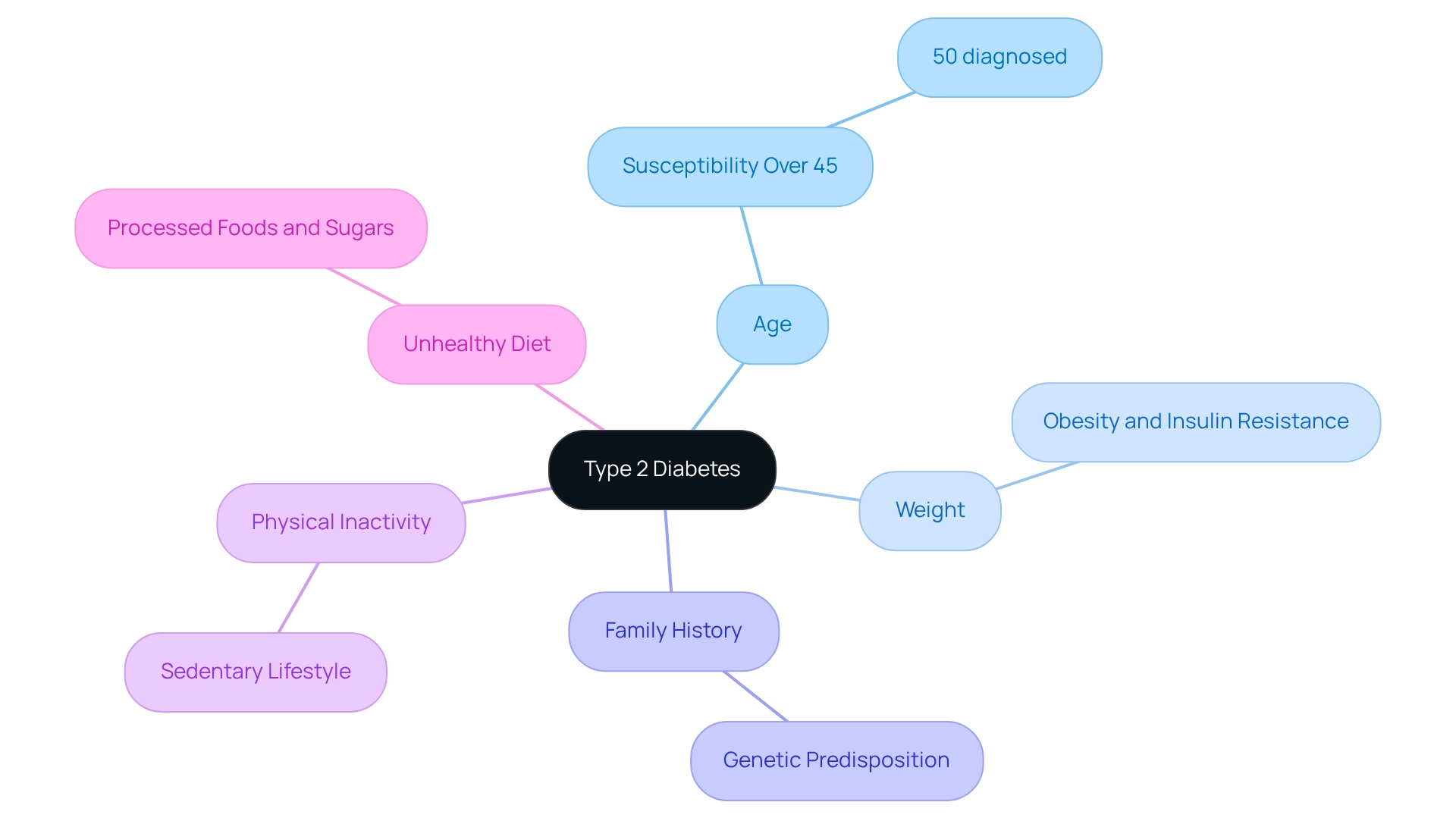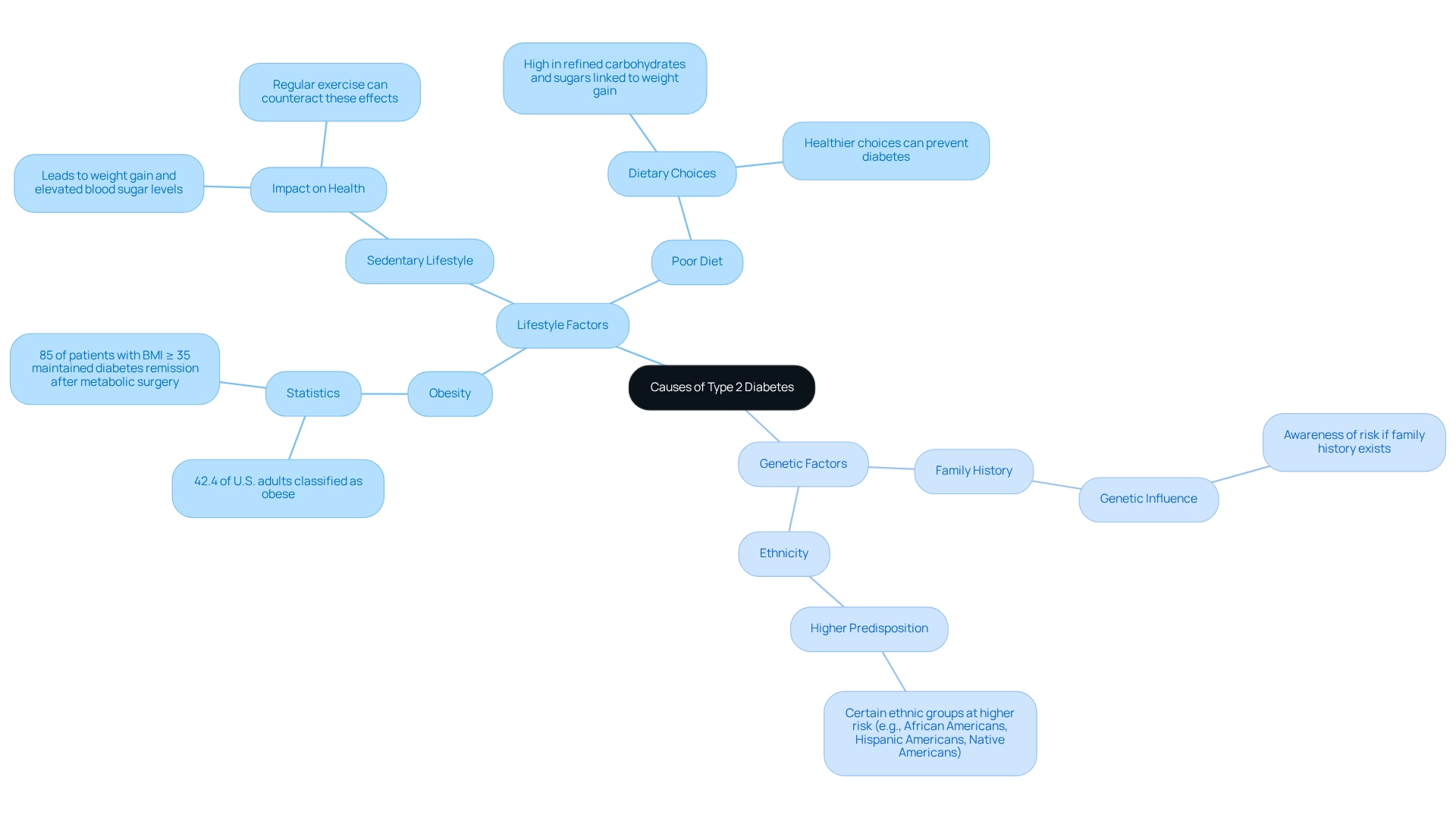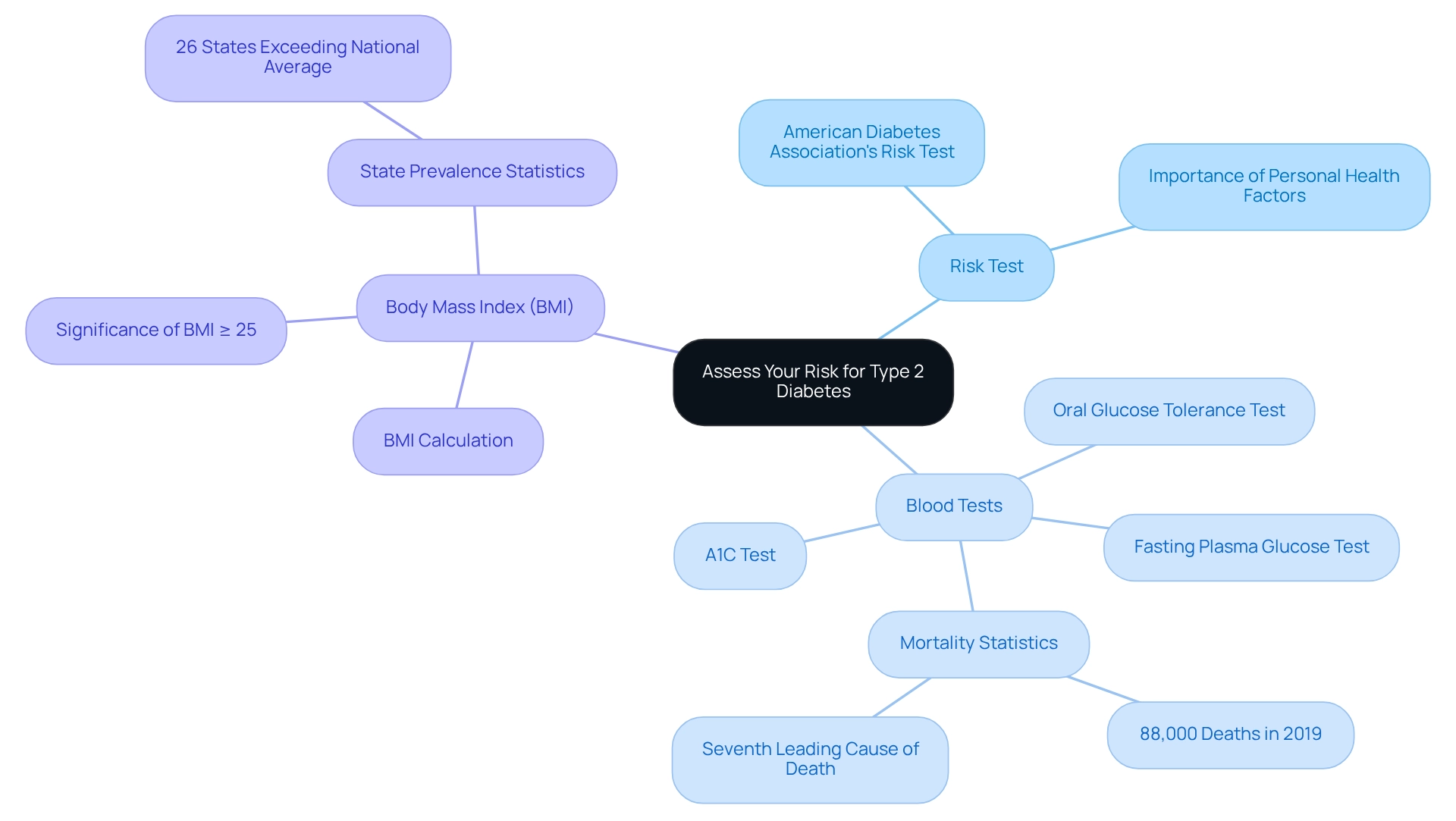Overview
Understanding the main causes and risks of developing Type 2 diabetes is essential for your health journey. Factors such as age, obesity, family history, physical inactivity, and poor diet contribute significantly to this condition. It's understandable to feel overwhelmed by this information, but recognizing these risk factors can empower you to take proactive steps.
By acknowledging these risks, you can begin to manage your health more effectively. Remember, you’re not alone in this journey. Many people share similar concerns, and there are resources available to support you. Taking action now can reduce your likelihood of developing Type 2 diabetes and help you lead a healthier life.
We are here to support you every step of the way, encouraging you to seek out information and assistance that resonates with your needs. Together, we can navigate this path towards better health.
Introduction
In a world where chronic diseases are increasingly common, Type 2 Diabetes emerges as a significant health concern affecting millions around the globe. This condition, characterized by insulin resistance, not only raises blood sugar levels but also poses serious risks to overall well-being. Understanding the various factors that contribute to its development—from age and weight to lifestyle choices and genetic predisposition—is essential for prevention and management.
With alarming statistics showing a rise in diabetes cases, particularly among youth and minority groups, recognizing symptoms and assessing personal risk has never been more urgent. It’s understandable to feel overwhelmed by this information, but know that you are not alone. This article explores the vital aspects of Type 2 Diabetes, providing insights into its causes, symptoms, and the resources available for effective risk assessment. Together, we can empower you to take proactive steps toward better health.
Understand Type 2 Diabetes: Definition and Risk Factors
Condition 2 is a chronic ailment defined by insulin resistance, where the body does not effectively use insulin, resulting in increased blood sugar levels. Understanding how you can get type 2 diabetes by recognizing the contributing factors linked to this condition is vital for your health journey:
- Age: If you're 45 or older, you may be especially susceptible, with around 50% diagnosed with this form of Mellitus. This statistic highlights the importance of monitoring your health as you age.
- Weight: Being overweight or obese can significantly increase your risk of developing this condition, as excess body fat contributes to insulin resistance.
- Family History: A genetic predisposition can elevate your risk, making family history a crucial factor in assessing your individual susceptibility.
- Physical Inactivity: A sedentary lifestyle not only contributes to weight gain but also exacerbates insulin resistance, further increasing your risk of this condition.
- Unhealthy Diet: Diets rich in processed foods, sugars, and unhealthy fats are linked to obesity and, consequently, Type 2 condition.
Recent studies indicate a concerning trend: from 2002 to 2018, the incidence of Type 2 condition among youth, particularly in minority groups, has risen sharply. This highlights the urgent need for public health initiatives. Moreover, statistics show that around 73,000 lower-limb amputations were conducted in diabetics aged 20 and older, underscoring the serious complications linked to uncontrolled blood sugar levels. It's also important to note that individuals with the ailment are twice as likely to experience depression compared to those without the condition, illustrating the multifaceted impact of this disease. The World Health Organization (WHO) observes that in developing nations, over half of all cases of this condition remain undiagnosed, which raises the question of how you can get type 2 diabetes, highlighting the importance of recognizing these risk factors for understanding your personal risk and taking proactive measures toward managing your health.
At T2DSolutions, we are committed to providing resources and support for newly diagnosed patients. We offer educational materials and community initiatives to help you navigate your diabetes journey. Remember, you're not alone in this journey—explore T2DSolutions for additional information and assistance regarding the management of condition 2 related to blood sugar.

Identify Causes of Type 2 Diabetes: Lifestyle and Genetic Factors
At T2DSolutions, we understand the importance of equipping individuals with vital information about Type 2 Diabetes, including its causes and contributing factors. The causes can be broadly categorized into lifestyle and genetic factors:
-
Lifestyle Factors:
- Obesity: Excess body fat, especially around the abdomen, plays a significant role in insulin resistance. In the U.S., obesity rates have surged, with approximately 42.4% of adults classified as obese. This highlights a direct correlation with the rising prevalence of Type 2 Diabetes. For instance, in patients with a BMI of 35 or greater who underwent metabolic surgery, 85% maintained diabetes remission for up to two years, while no patients in the medical therapy group achieved this.
- Sedentary Lifestyle: A lack of physical activity can lead to weight gain and elevated blood sugar levels, increasing the risk of developing diabetes. Regular exercise can counteract these effects and improve overall health. It's understandable to feel overwhelmed, but engaging in physical activity is a positive step forward.
- Poor Diet: Diets high in refined carbohydrates and sugars are linked to weight gain and insulin resistance. Making healthier dietary choices can play a crucial role in diabetes prevention. Remember, small changes can lead to significant improvements.
-
Genetic Factors:
- Family History: Genetics significantly influence diabetes risk. If you have a family history of diabetes, it's essential to be aware of your risk and take proactive health measures. You're not alone in this journey; many face similar challenges.
- Ethnicity: Certain ethnic groups, including African Americans, Hispanic Americans, and Native Americans, have a higher predisposition to Type 2 Diabetes. This necessitates targeted public health initiatives to support these communities.
Recognizing these causes empowers individuals to make informed lifestyle choices that can significantly reduce their risk. For instance, a case study revealed that in 2021, an estimated 97.6 million Americans aged 18 and older had prediabetes, indicating a pressing need for education and preventive measures. Moreover, lifestyle modifications, including weight control and enhanced physical activity, have demonstrated a reduction in the likelihood of developing Type 2 Diabetes. A meta-analysis published in the British Journal of Surgery indicates that metabolic surgery is superior to medical treatment alone in preventing microvascular complications related to blood sugar disorders. This reinforces the importance of addressing obesity in prevention strategies.
This comprehensive approach highlights the urgency of making informed lifestyle choices and considering all available treatment options. We are here to support you every step of the way. For more resources and support, visit T2DSolutions to learn how you can manage your health effectively.

Recognize Symptoms of Type 2 Diabetes: Early Warning Signs
Recognizing Symptoms of Type 2 Diabetes: Early Warning Signs
It's understandable to feel overwhelmed when facing health concerns. Early symptoms of Type 2 Diabetes often go unnoticed, yet recognizing them is vital for timely diagnosis and effective management. Common warning signs include:
- Increased Thirst: A persistent feeling of thirst that does not subside.
- Frequent Urination: An increased need to urinate, particularly at night.
- Extreme Hunger: Experiencing intense hunger even after meals.
- Fatigue: Unusual tiredness or a lack of energy.
- Blurry Vision: Noticeable changes in vision, such as blurriness.
- Slow Healing: Cuts and bruises that heal more slowly than expected.
Awareness of these symptoms can prompt timely medical consultations, which are essential for effective management of this condition. Did you know that 252 million individuals are living with undiagnosed blood sugar issues? This statistic underscores the critical need for vigilance regarding these early warning signs. Recognizing these symptoms can significantly improve outcomes, as early detection allows individuals to collaborate with healthcare providers to create personalized management plans.
As Shamard Charles, MD, MPH, notes, "New medications and screening techniques have improved diagnostics and treatment, and a renewed emphasis on eating a balanced diet and maintaining a healthy weight can make a difference." For those with risk factors like excess belly fat or a sedentary lifestyle, it’s important to consult healthcare professionals to evaluate how can you get type 2 diabetes and other related health issues. Remember, you’re not alone in this journey. By collaborating with a care team for blood sugar management, you can establish realistic objectives that improve your likelihood of controlling or preventing Type 2 effectively.
Furthermore, T2DSolutions seeks to offer valuable resources and support for individuals managing their condition. We encourage you to enroll for notifications on research developments and health advice concerning this condition, ensuring continuous learning and assistance. Together, we can navigate this path towards better health.

Assess Your Risk: Tools and Tests for Type 2 Diabetes
To effectively evaluate your risk for Type 2 Diabetes and to answer the question of how can you get type 2 diabetes, consider utilizing the following tools and tests, and explore how T2DSolutions can support you in this journey:
-
Risk Test: Online assessments, such as the American Diabetes Association's risk test, are valuable for assessing your likelihood of developing the condition based on personal health factors. It's understandable to feel concerned about your health, especially with recent statistics indicating that approximately 8.0% of U.S. adults with diagnosed blood sugar issues had a non-HDL level of 190 mg/dL or higher. Understanding your health metrics is crucial, and T2DSolutions provides resources to assist you in interpreting your results and taking proactive measures for prevention.
-
Blood Tests: Regular blood tests are essential for diagnosing blood sugar disorders and prediabetes. Key tests include the A1C test, fasting plasma glucose test, and oral glucose tolerance test. These tests provide essential insights into your blood sugar levels and overall metabolic health, enabling timely interventions if necessary. It's important to note that nearly 88,000 deaths in the U.S. in 2019 resulted from blood sugar disorders, making it the seventh leading cause of death. This emphasizes the need for regular monitoring, and T2DSolutions can guide you on how to discuss these tests with your healthcare provider.
-
Body Mass Index (BMI): Calculating your BMI is an important step in understanding your weight status. A BMI of 25 or more signifies being overweight, leading to concerns about how can you get type 2 diabetes. Monitoring your BMI can help you identify areas for improvement in your lifestyle choices. Moreover, it's important to mention that 26 states and territories have a diabetes prevalence exceeding the national average, which may influence your personal evaluation. T2DSolutions provides tools and tips for maintaining a healthy weight and lifestyle, helping you understand how can you get type 2 diabetes while guiding necessary lifestyle changes or medical interventions to mitigate your risk. Remember, you're not alone in this journey. For more resources and support, be sure to explore T2DSolutions.

Conclusion
Understanding Type 2 Diabetes is crucial in today's health landscape, where its prevalence continues to rise, particularly among vulnerable populations. It's understandable to feel overwhelmed by this information, but recognizing the significant risk factors associated with this condition—such as age, weight, family history, physical inactivity, and diet—empowers you to assess your personal risk. By taking proactive steps toward prevention and management, you can regain a sense of control over your health.
The discussion of lifestyle and genetic causes further emphasizes the importance of informed choices. Factors like obesity, sedentary habits, and poor dietary practices can directly contribute to the development of Type 2 Diabetes. By making healthier lifestyle adjustments and being aware of your genetic predispositions, you can significantly reduce your risk and improve your overall health. Remember, you're not alone in this journey; many have walked this path and found success.
Moreover, early recognition of symptoms is vital for effective management. Increased thirst, frequent urination, extreme hunger, fatigue, blurry vision, and slow healing are key warning signs that should not be ignored. If you notice these symptoms, timely medical consultations can lead to personalized management plans, improving outcomes for those at risk or living with the condition.
Finally, utilizing available tools and tests, such as risk assessments and blood tests, helps you gauge your health status and make informed decisions. By actively engaging in health monitoring and seeking educational resources, such as those offered by T2DSolutions, you can take charge of your health journey. Remember, seeking support is a sign of strength.
In summary, awareness, education, and proactive measures are essential in the fight against Type 2 Diabetes. By understanding risk factors, recognizing symptoms, and utilizing assessment tools, you can empower yourself to make positive lifestyle changes. Together, we can reduce the risk of this chronic condition and support each other along the way.
Frequently Asked Questions
What is Condition 2, and how is it defined?
Condition 2, or Type 2 diabetes, is a chronic ailment characterized by insulin resistance, where the body does not effectively use insulin, leading to increased blood sugar levels.
What are the main contributing factors to developing Type 2 diabetes?
The main contributing factors include age (especially 45 or older), being overweight or obese, family history of diabetes, physical inactivity, and an unhealthy diet rich in processed foods and sugars.
How does age affect the risk of developing Type 2 diabetes?
Individuals who are 45 years or older are particularly susceptible to Type 2 diabetes, with around 50% diagnosed with this form of the condition.
What role does weight play in the risk of Type 2 diabetes?
Being overweight or obese significantly increases the risk of developing Type 2 diabetes, as excess body fat contributes to insulin resistance.
How does family history influence the risk of Type 2 diabetes?
A genetic predisposition can elevate an individual's risk of developing Type 2 diabetes, making family history an important factor to consider.
Why is physical inactivity a risk factor for Type 2 diabetes?
A sedentary lifestyle contributes to weight gain and exacerbates insulin resistance, further increasing the risk of developing Type 2 diabetes.
How does diet impact the risk of Type 2 diabetes?
Diets high in processed foods, sugars, and unhealthy fats are linked to obesity, which is a significant risk factor for developing Type 2 diabetes.
What alarming trend has been observed regarding Type 2 diabetes in youth?
From 2002 to 2018, there has been a concerning rise in the incidence of Type 2 diabetes among youth, particularly in minority groups.
What serious complications are linked to uncontrolled blood sugar levels in diabetics?
Serious complications include a high number of lower-limb amputations, with around 73,000 conducted in diabetics aged 20 and older.
How does Type 2 diabetes affect mental health?
Individuals with Type 2 diabetes are twice as likely to experience depression compared to those without the condition.
What is the status of Type 2 diabetes diagnosis in developing nations?
The World Health Organization (WHO) notes that over half of all cases of Type 2 diabetes in developing nations remain undiagnosed.
What resources does T2DSolutions offer for newly diagnosed patients?
T2DSolutions provides educational materials and community initiatives to support newly diagnosed patients in managing their diabetes journey.



